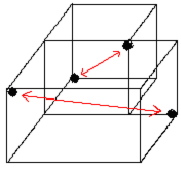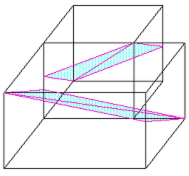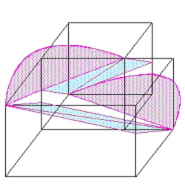JMM 2, Spring 2004, section 6
Felipe Otondo & Jorge Soto
THREE DIAGONAL STRATEGIES FOR A SOUND INSTALLATION
6.1. Introduction
The idea for a sound installation in an art gallery began as a collaboration which aimed to integrate ideas of sound spatialization and the manipulation of spatial perception from an architectural point of view. The challenge was to apply and test concepts common both to space and sound in a way that would fit a selected location. The location chosen for this purpose was Galerie PI, located in Copenhagen, Denmark, consisting of two connected rooms where exhibitions take place on a daily basis (Galerie PI, 2004). In accordance with this motivation, three main strategies were designed to actualize the idea of sound in a space containing visual art components. The objective of these strategies was to explore the possibilities of spatial awareness through the overcoming of normal parameters, both in the physical space and in created sound fields.
6.2. Some Properties og the Diagonal in Architecture and Visual Arts
A typical sound installation with loudspeakers has many characteristics in common with the classical space paradigm that has ruled our spatial awareness from the Renaissance up to the present. This involves a symmetrical and static space in which events occur in a horizontal plane defined by the listener and by the two loudspeakers that are placed at the same level as the listener and at the same distance from him or her. This sound plane is parallel to the planes of the floor and of the ceiling that define the physical space.
Since the 1920’s the concepts and ideas of the avant-garde have been a challenge for architecture and the visual arts, since they attempt to break the perspective box of the Renaissance and to find means of dealing with a more complex spatial paradigm (Panoffsky, 1991). In this context, the use of the diagonal has been one of the main tools used in theoretical approaches to spatiality because of its inherent properties, namely the abilities of diagonals to express time, movement and deph. For Theo van Doesburg, for instance, the diagonal was the means employed to introduce movement in the neoplastic (Mondrian, 1995), orthogonal and two-dimensional world (Doesburg, 1995).
Clearly this has not been the dominant tendency in the architectonic avant-garde, which was seduced by Mondrian’s and Van der Rohe’s simplifying ideals. The diagonal has always been used in alternative approaches to spatial theorizing, however, and where complexity and synesthesia were more important than simplicity and propaganda. A more with less approach against the famous less is more attitude (Campo Baéza, 1992).
Let’s have a look at some of the properties of the diagonal that can be interesting in the context of sound in spaces.
1) Depth: The diagonal is used to express depth by means of two different mechanisms. The first one is in its accepted role as a perspective line with which we are well acquainted from painting and photography. This means that a diagonal line is interpreted optically by our brain as a possible plane perceived depth, as a foreshortening mark. The second mechanism comes from the world of paper sculpture, such as the Japanese origami and also other European paper-folding disciplines, where the elements that are unfolded are expressed as diagonals when the figure is seen as a two-dimensional object (Engel, 1989). This means that diagonals in a plane express both the folds, which make possible the depth of these objects, and the perspective lines that situate them in space.
2) Movement: The diagonal can be used in many ways to express movement. One of them is related to depth To express depth is almost to extend an invitation to move into a space along a diagonal. To follow the diagonal of a perspective line visually is a kind of movement or the possibility of this movement. This is also expressed in the diagonal made by each fold in a textile or paper surface and representing a movement of the material, a displacement from a plane to a three dimensional form that is expressed with the diagonal as an overlapping of the material.
Natural movements in space also follow diagonals and not straight lines, so that the use of physical diagonal lines functions also as an invitation to the movement or a representation of the movement itself, a trajectory mark.
3) Time: The ability of the diagonal to express time is connected with the other two properties mentioned above: movement and depth In a three-dimensional world all operations that manipulate one of these dimensions have a temporal consequence. Usually the two-dimensional simplification results in a kind of eternal time, because the loss of depth always works as stopped time, and also as a geometrical regulator that eliminates all the diagonal elements which are the remains of folds and perspective phenomena. We become confronted with the two-dimensional object that appears detained in a perfect and eternal second. The diagonal, on the contrary, expresses movement, and the movement itself means a time sequence, a transition period between two positions and instants (Soto, 1998).
These are some of the reasons for the use of the diagonal by architects and visual artists, normally done in a more or less tangible way, meaning that the diagonal is present either physically or visually. Light is the most intangible resource that architects have found to tighten space through the use of diagonals. Since roman time zenithal light has been used to strain the space through moving diagonals that introduce time in the architectonic space, which thus becomes a sublime space (Campo Baéza, 1999, 2000).
In the present work we intend to go a step further and use the diagonal in space in a totally abstract way, without any visual representation or metaphor for it, just with sounds – sounds that define the diagonals of the space and that create a meta-space as a combination of physical and acoustical parameters.
6.3. First Strategy: Diagonalising the Rooms
The first strategy designed for the installation was related to the idea of local movement inside each of the connected rooms, particularly defining a space of movement and temporal sequence inside the diagonals of each one of the rooms. This idea implied the design of flexible sound fields inside each of the rooms by means of two loudspeakers located in each of the extremes of a diagonal, trying to emphasize the idea of focalization and spaciousness of sound within the room as perceived by the listener (Beranek, 1996).
The degree of spatialization of sound within the room was obtained by manipulating the levels and spectral content of the radiated sound as a way to distribute sound in the generated sound field. This meant that the movement of sound within the room could oscillate between the extreme cases of, on the one hand, focalized sound at one of the extremes of the diagonal and, on the other hand, the situation where the sound level through both loudspeakers was similar, thus creating a situation of maximum spaciousness. In this latter situation, the presence of the room is emphasized and the position of the sound source cannot be easily identified. It is important to emphasise the practical character of the diagonal in the vertical plane as a way to break the static nature of sound movement along the horizontal axis in the room. Figure 1 shows the sound diffusion plane in two similar locations, one with the loudspeakers located at the same height and the other in the proposed configuration with loudspeakers at different heights.
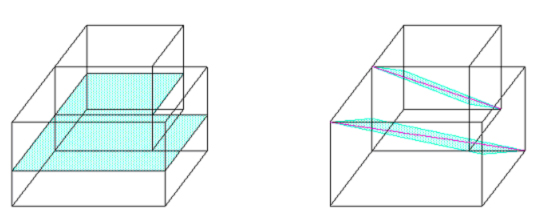 Figure 1 Example of the sound diffusion plane in two rooms with two different loudspeaker configurations. The first figure (left) shows the classical placement of loudspeakers at the same height and the second figure (right) shows a placement of loudspeakers at different heights at the extremes of two diagonals.
Figure 1 Example of the sound diffusion plane in two rooms with two different loudspeaker configurations. The first figure (left) shows the classical placement of loudspeakers at the same height and the second figure (right) shows a placement of loudspeakers at different heights at the extremes of two diagonals.The positioning of the loudspeakers in each of the rooms was planned in a way that could invite the listener to move through the space and as a means to connect the spaces acoustically, as will be explained later. As shown in Figure 2 the location of the highest loudspeaker in each of the rooms is beside and above the entrance.
It is thus not easy for the listener to localise the origin of the sound source when entering the room. On the other hand, the lowest loudspeaker is placed in the opposite corner of the room, far away from the entrance, so that it becomes a more pointed sound source that invites the visitor to move trough the space following the sound.
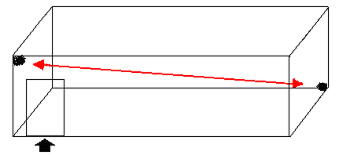 Figure 2 The diagonal of sound in one of the rooms as an expression of the axis of the movement in the local scale.
Figure 2 The diagonal of sound in one of the rooms as an expression of the axis of the movement in the local scale.
6.4. Second Strategy: Torsion Through the Disposition of Diagonals
The second strategy for the installation was to define a second kind of movement, the total movement, as one that would develop across spaces integrating the spatial and acoustical qualities of the two rooms with each other, in order to incite the listener to relate them freely. This was also done with the purpose of inciting the movement of listeners between the locations by means of sounds, and also to suggest a double awareness of the two spatial scales. The position of the sound sources and their heights was conceived in such a way as to help to connect local movements defined by the diagonals in each of the rooms with the overall movements between the rooms. The disposition of these diagonals in the two spaces in crossed juxtaposition was planned in such a way as to lend more flexibility to the local movements within each room, and also in order to link both local movement patterns together in the total movement across the rooms.
Figure 3 Pictures of the coupled rooms showing the crossed disposition of the diagonals of loudspeakers (left), the sound diffusion planes (center) and the spatial torsion between spaces (right). In a more predictable solution the disposition of the loudspeakers could have followed the same pattern in both rooms, as shown in Figure 1 (right) with the highest loudspeaker placed in the left side of the room in relation to the entrance of each room. This disposition would have assumed a repetition of the acoustical and spatial properties of both rooms and the threshold, created as a connection between them, would have been almost a repetition of the main entrance of the first space, an anticlimax or a new frontier, but not an articulated element.
The crossed disposition of the diagonals was intended to bring about a spatial interconnection between the two rooms which would work perceptually so as to induce a sort of torsion in the space. This will occur, because our senses, identifying one sound disposition in the first room, will assume that this will be repeated in the second, but - unexpectedly - it will reoccur in an inverted fashion. In this way when we move through the threshold between the two rooms, we experience a strong lack of spatial orientation produced by the spatial torsion between the two spaces, which creates a kind of perceptual continuum.
The presence and absence of sounds in the rooms was defined by manipulating the sound intensity in each of the rooms according to a global structure that will be explained in the next strategy. The idea was that when the sound in one room was louder than the one in the other room, where there was another sound or silence, the louder sound could be perceived as an external component in the second room, influencing the local space as an external component, reinforcing the sense of movement across the rooms.
6.5. Third Strateegy: Global Sonic Framework
The evolution of sounds in time was designed to create a global temporal framework that could integrate the local and total movement, allowing an open approach with the possibility of focus in one of the rooms or in the linked space as a whole. For this purpose, the goal was to develop global temporal structures that would emphasize the spatial awareness of the independent and connected acoustical spaces, facilitating possible interactions between spaces and also an internal process in each of the rooms.
As in the case of music designed for a particular location with a particular functionality (Eno, 1996), the particular type of sound material selected in this case for the installation was continuous long sounds of related and different sonorities that could help reinforce the idea of integration and rejection of spaces in the installation. Long recorded tones of three wind instruments - a tuba, a French horn and a bass clarinet - were used as basic material to create sounds to be reproduced in the installation. Initially, the original short tones recorded from the instruments were electronically stretched in time in order to allow small variations in amplitude and pitch of the original tones to be magnified on a larger time scale in new longer sounds. These time-stretched tones were then convolved with the original tones of the same instrument or of one of the other two instruments in order to create timbre blending, following a similar process used in a previous work (Otondo, 2003). The transformations of the sounds in time and in spectra were carried out in such way that an attempt was made to preserve the original timbre of the instruments to a high extent, while allowing gradual changes in dynamics and spectra. Figure 4 shows some sound samples of timbre blending used in the installation. The samples include the type of spatialization reproduced through loudspeakers at the two extremes of the diagonal, which will be heard in the sample as distributed between the two sides of loudspeakers or headphones.
 Figure 4 Sound samples of the type of sounds used in the installation. Each of the sounds relates to a different timbral combination and can be listened to by clicking on each oval.
Figure 4 Sound samples of the type of sounds used in the installation. Each of the sounds relates to a different timbral combination and can be listened to by clicking on each oval. The convolved sounds which were obtained as a result of, different timbral combinations of the three instruments, were then used as a basis for building the overall structure for the evolution of events in the installation. Sounds were grouped in four groups of timbre blending: tuba combined with tuba, tuba combined with bass clarinet, tuba combined with French horn and French horn combined with bass clarinet. Each of the groups of sounds were then named after the letters A, B, C and D, according to their original timbre components, and each of the convolved sounds were named with one of these letters and a number related to its order in the group.
The global time framework was designed taking two streams of events into consideration, each one related to the sounds reproduced in each of the two rooms, allowing for the possibility of superposition of events as well as for one single event during an interval of silence in one of the rooms. Each of the events used in the global framework had its internal evolution in the spatialization of sound between the two loudspeakers in each of the diagonals of the rooms (local movement). The overall evolution of movement between the two spaces (total movement) was outlined as the existence or non-existence of sound in a room as well as the integration or disintegration of timbres of the reproduced sounds in the resulting linked space. Figure 5 shows an example of the global time framework with the two streams of events in each of the two linked rooms. Local movement of each of the sound streams is depicted as a red line moving in the diagonal from loudspeaker a to b and the external movement across spaces depicted as a dark line inside green ovals showing the level of sound interaction between the rooms.
 Figure 5 Example of total and local sonic movements in the installation in a period of time with four types of timbres (A, B, C, D). The red lines show the local movements within the rooms for particular sounds and the green ovals with dark arrows show the movement interaction from one room to the other in a particular time position.
Figure 5 Example of total and local sonic movements in the installation in a period of time with four types of timbres (A, B, C, D). The red lines show the local movements within the rooms for particular sounds and the green ovals with dark arrows show the movement interaction from one room to the other in a particular time position.The structure of the evolution of events in the global framework of the installation was designed choosing an arbitrary temporal structure of events for each of the rooms. As in music which assumes a certain structural basis for groups of rhythmic motives (Pritchett, 1996), a disposition of events was created for each of the rooms associating one of the four types of sonorities for a certain period of time in each of the rooms. The two structures worked as two independent streams, being indirectly synchronized in the durations and disposition of events to allow interactions of the kind shown in Figure 5.
6.6. Conclusions
The development of strategies for sound in spaces, explained and exemplified in this work, shows positively that architecture and sound experimentation can work together in the definition of a meta-space.
The first implementation of some of the ideas of this work in a demonstration with loudspeakers in the gallery showed, on the one hand, the interesting effect of movement created by locating loudspeakers at the extremes of a diagonal at different heights as shown in Figure 1. On the other hand, and more astonishingly, the acoustical effect of the positioning of crossed diagonals between the rooms defined a very particular sonic experience, which provoked a new spatial awareness with very simple means. From the initial tests, it became quite clear that when the listener moved between the two spaces, the rotation of the rooms achieved by the cross-juxtaposition of the diagonals in the two spaces, together with the effect of crossing the threshold between the two rooms, was quite remarkable. The crossing of diagonals not only introduces the torsion movement, but also completely differentiates the two sonic thresholds: the entrance to the first room from the street is differentiated from the connection between the two rooms. The first one is a clear door to the space, while the second one is an acoustic vortex, an element that articulates the total space by defining the perceptual torsion between the two rooms.
As a further development of the ideas presented in this article, we believe that the strategies could be tried in different locations utilizing alternative positioning of loudspeakers as well as different types of sound material. It is possible that the physical and acoustical properties of different enclosures, as well as the use of particular types of timbres could actualize the ideas outlined in this article to an even greater extent, opening new possibilities for the use of sound in space.
 Figure 1 Example of the sound diffusion plane in two rooms with two different loudspeaker configurations. The first figure (left) shows the classical placement of loudspeakers at the same height and the second figure (right) shows a placement of loudspeakers at different heights at the extremes of two diagonals.
Figure 1 Example of the sound diffusion plane in two rooms with two different loudspeaker configurations. The first figure (left) shows the classical placement of loudspeakers at the same height and the second figure (right) shows a placement of loudspeakers at different heights at the extremes of two diagonals.

